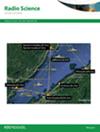A software tool for the true height analysis of ionograms using the iterative gradient correction (IGC) method
IF 1.6
4区 地球科学
Q3 ASTRONOMY & ASTROPHYSICS
引用次数: 0
Abstract
Deriving the precise true height electron density profile from the measured ionosonde virtual heights is quite a challenging problem. Recently, Ankita and Tulasi Ram (2023, https://doi.org/10.1029/2023RS007808) presented a new method, Iterative Gradient Correction (IGC) method, for true height analysis that uses HF radio wave propagation path computations to reconstruct the true height profile. Through iterative corrections on electron density gradients between successive points, the IGC method minimizes errors below a specified tolerance at each point and reconstructs a complete electron density profile. The derived profiles from the IGC method are found to be accurate when compared with Incoherent Scatter Radar and Global Navigation Satellite System—Radio Occultation observations. To facilitate true height analysis by IGC method for a wider user community, a MATLAB-based software has been developed and is outlined in this report. The software can be installed on any Windows platform and is designed with a user-friendly interface for easy and efficient application by the users. It can analyze multiple scaled ionograms in a single run and outputs the real height profiles in ASCII format. Further, the software also captures important ionospheric parameters such as the base altitudes and peak frequencies of E- and F-layers (e.g., hE, hF, foE, and foF2) etc., from the computed true height profiles and tabulates in a separate output file for the ready use. The software also provides the option for extrapolation of true height profile into top-side ionosphere up to a user-specified height and reconstructs the complete vertical electron density profile.使用迭代梯度校正法(IGC)分析离子图真实高度的软件工具
从测量的电离层探测仪虚拟高度得出精确的真实高度电子密度剖面是一个相当具有挑战性的问题。最近,Ankita 和 Tulasi Ram(2023,https://doi.org/10.1029/2023RS007808)提出了一种用于真实高度分析的新方法--迭代梯度校正法(IGC),该方法利用高频无线电波传播路径计算来重建真实高度剖面。通过对连续点之间的电子密度梯度进行迭代修正,IGC 方法可将每个点的误差降至指定容差以下,并重建完整的电子密度剖面。与相干散射雷达和全球导航卫星系统无线电掩星观测结果相比,IGC 方法得出的剖面图非常准确。为了方便更多用户使用 IGC 方法进行真实高度分析,我们开发了一个基于 MATLAB 的软件,本报告对此进行了概述。该软件可安装在任何视窗平台上,界面设计友好,便于用户高效应用。它可以在一次运行中分析多个缩放离子图,并以 ASCII 格式输出实际高度剖面图。此外,该软件还能从计算出的真实高度剖面图中捕获重要的电离层参数,如 E 层和 F 层的基底高度和峰值频率(如 hE、hF、foE 和 foF2)等,并将其制成表格,存入单独的输出文件中,以备随时使用。该软件还可将真实高度剖面外推至用户指定高度的顶部电离层,并重建完整的垂直电子密度剖面。
本文章由计算机程序翻译,如有差异,请以英文原文为准。
求助全文
约1分钟内获得全文
求助全文
来源期刊

Radio Science
工程技术-地球化学与地球物理
CiteScore
3.30
自引率
12.50%
发文量
112
审稿时长
1 months
期刊介绍:
Radio Science (RDS) publishes original scientific contributions on radio-frequency electromagnetic-propagation and its applications. Contributions covering measurement, modelling, prediction and forecasting techniques pertinent to fields and waves - including antennas, signals and systems, the terrestrial and space environment and radio propagation problems in radio astronomy - are welcome. Contributions may address propagation through, interaction with, and remote sensing of structures, geophysical media, plasmas, and materials, as well as the application of radio frequency electromagnetic techniques to remote sensing of the Earth and other bodies in the solar system.
 求助内容:
求助内容: 应助结果提醒方式:
应助结果提醒方式:


